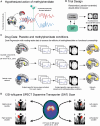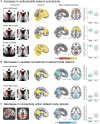Methylphenidate differentially alters corticostriatal connectivity after traumatic brain injury
- PMID: 39432756
- PMCID: PMC11969465
- DOI: 10.1093/brain/awae334
Methylphenidate differentially alters corticostriatal connectivity after traumatic brain injury
Abstract
Traumatic brain injury commonly impairs attention and executive function and disrupts the large-scale brain networks that support these cognitive functions. Abnormalities of functional connectivity are seen in corticostriatal networks, which are associated with executive dysfunction and damage to neuromodulatory catecholaminergic systems caused by head injury. Methylphenidate, a stimulant medication that increases extracellular dopamine and noradrenaline, can improve cognitive function following traumatic brain injury. In this experimental medicine add-on study to a randomized, double-blind, placebo-controlled clinical trial, we test whether administration of methylphenidate alters corticostriatal network function and influences drug response. Forty-three moderate-severe traumatic brain injury patients received 0.3 mg/kg of methylphenidate or placebo twice a day in 2-week blocks. Twenty-eight patients were included in the neuropsychological and functional imaging analysis (four females, mean age 40.9 ± 12.7 years, range 20-65 years) and underwent functional MRI and neuropsychological assessment after each block. 123I-Ioflupane single-photon emission computed tomography dopamine transporter scans were performed, and specific binding ratios were extracted from caudate subdivisions. Functional connectivity and the relationship to cognition were compared between drug and placebo conditions. Methylphenidate increased caudate to anterior cingulate cortex functional connectivity compared with placebo and decreased connectivity from the caudate to the default mode network. Connectivity within the default mode network was also decreased by methylphenidate administration, and there was a significant relationship between caudate functional connectivity and dopamine transporter binding during methylphenidate administration. Methylphenidate significantly improved executive function in traumatic brain injury patients, and this was associated with alterations in the relationship between executive function and right anterior caudate functional connectivity. Functional connectivity is strengthened to brain regions, including the anterior cingulate, that are activated when attention is focused externally. These results show that methylphenidate alters caudate interactions with cortical brain networks involved in executive control. In contrast, caudate functional connectivity reduces to default mode network regions involved in internally focused attention and that deactivate during tasks that require externally focused attention. These results suggest that the beneficial cognitive effects of methylphenidate might be mediated through its impact on the caudate. Methylphenidate differentially influences how the caudate interacts with large-scale functional brain networks that exhibit co-ordinated but distinct patterns of activity required for attentionally demanding tasks.
Keywords: corticostriatal; executive dysfunction; functional connectivity; methylphenidate; traumatic brain injury.
© The Author(s) 2024. Published by Oxford University Press on behalf of the Guarantors of Brain.
Conflict of interest statement
The authors report no competing interests.
Figures




References
-
- Draper K, Ponsford J. Cognitive functioning ten years following traumatic brain injury and rehabilitation. Neuropsychology. 2008;22:618–625. - PubMed
-
- Pavlovic D, Pekic S, Stojanovic M, Popovic V. Traumatic brain injury: Neuropathological, neurocognitive and neurobehavioral sequelae. Pituitary. 2019;22:270–282. - PubMed
Publication types
MeSH terms
Substances
Grants and funding
LinkOut - more resources
Full Text Sources
Medical

